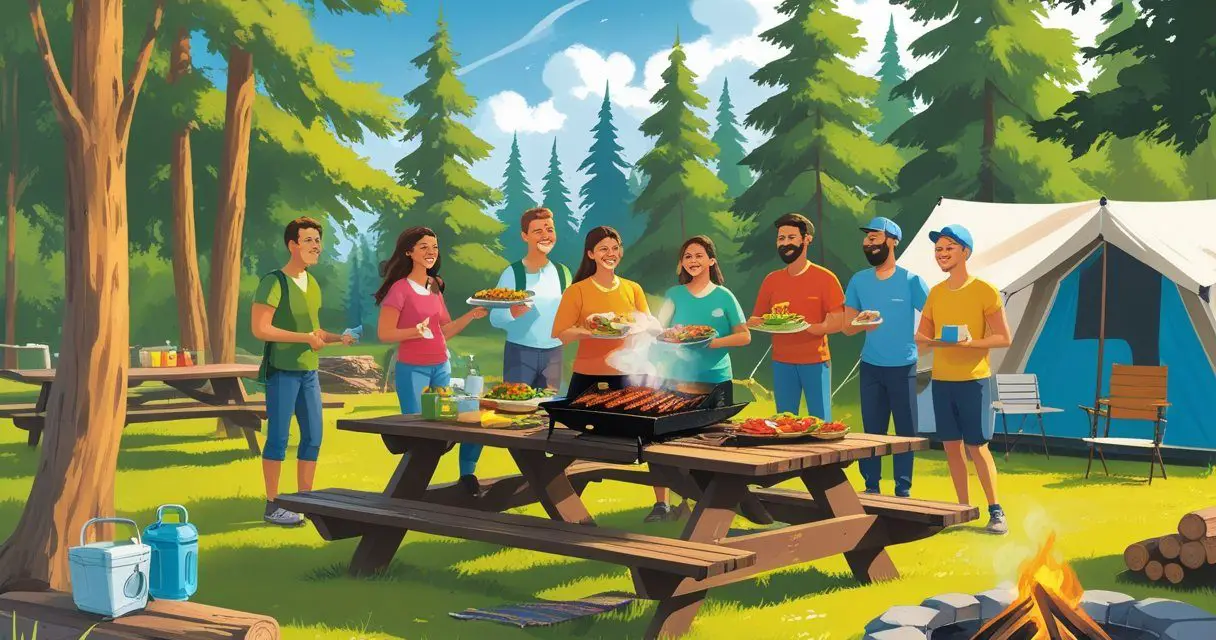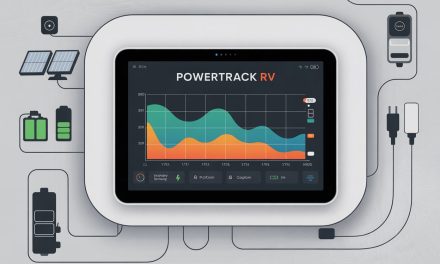Would you like to save this article?
The freedom of RV life allows us to experience the joy of preparing delicious meals under open skies, surrounded by nature’s beauty. However, cooking outdoors in an RV environment comes with unique food safety challenges that aren’t present in traditional kitchens. According to the CDC, approximately 48 million people get sick from foodborne illnesses each year in the United States, with outdoor cooking being a particularly high-risk scenario.
From temperature fluctuations to limited facilities, RV enthusiasts must be vigilant about food safety practices to prevent illness and ensure enjoyable travel experiences. Whether you’re grilling by a scenic mountain lake or preparing breakfast at a coastal campsite, understanding these seven essential food safety items will help keep your outdoor cooking adventures both delicious and safe.
1. Food Thermometers: Your Most Reliable Safety Tool
Food thermometers are essential for ensuring food safety when cooking outdoors. According to the USDA Food Safety and Inspection Service, using a food thermometer is the only reliable way to determine if meat, poultry, and other foods have reached a safe internal temperature to destroy harmful bacteria. When cooking in an RV or at a campsite, environmental factors like wind and inconsistent heat sources can make it difficult to judge doneness by appearance alone. Statistics show that approximately 1 in 4 hamburgers turn brown before reaching the safe internal temperature of 160°F, highlighting why visual cues aren’t reliable. For optimal food safety, invest in a digital instant-read thermometer that provides quick, accurate readings and regularly calibrate it to ensure precision. Remember to insert the thermometer into the thickest part of the food, away from bone, fat, or gristle, and clean it with hot, soapy water between each use to prevent cross-contamination.
I once thought I was a “temperature whisperer” who could tell when meat was done just by poking it—turns out I was more of a “food poisoning predictor” until I bought a proper thermometer!
2. Proper Hand Washing Stations
Maintaining proper hand hygiene is critical when cooking outdoors, yet it’s often overlooked in RV and camping environments. According to the World Health Organization, inadequate hand hygiene contributes to approximately 600 million cases of foodborne illnesses globally each year. Creating a dedicated hand washing station at your RV cooking area significantly reduces this risk. Research from the CDC indicates that proper handwashing can reduce the risk of foodborne illness by up to 50%, making it one of the most effective preventive measures. Your outdoor hand washing setup should include clean running water, soap, paper towels, and a proper waste disposal container. For locations without access to running water, portable hand washing stations with foot pumps or battery-powered dispensers can be excellent alternatives. Remember to wash your hands for at least 20 seconds before and after handling food, after touching raw meat, and after any activity that could contaminate your hands.
My family used to think my portable hand washing station was overkill until that time at the beach when a seagull “blessed” our picnic table right before lunch—suddenly I was the hero of hygiene!
3. Proper Cooler Management and Temperature Control
Maintaining food at safe temperatures is particularly challenging when cooking outdoors, making cooler management essential for RV enthusiasts. According to the FDA, perishable foods should never remain in the “Danger Zone” (between 40°F and 140°F) for more than 2 hours, or 1 hour when outdoor temperatures exceed 90°F. Research shows that bacteria can double in number every 20 minutes in the danger zone, dramatically increasing foodborne illness risk. A study from Michigan State University found that 60% of outdoor coolers fail to maintain safe temperatures throughout a day of typical recreational use. To maximize cooler efficiency, pre-chill foods before packing, use sufficient ice or frozen gel packs (filling at least 25% of cooler space), separate raw meats from ready-to-eat foods using sealed containers, monitor internal temperatures regularly with a refrigerator thermometer, and replace ice as it melts. Consider using multiple coolers—one for frequently accessed items like beverages and another for perishable foods that need to stay consistently cold.
Last summer, I was so proud of how I’d organized our cooler until I realized I’d put the frozen steaks at the top and the beer at the bottom. Turns out physics doesn’t care about your dinner plans when warm air rises!
4. Cross-Contamination Prevention Tools
Preventing cross-contamination is crucial when cooking in limited RV spaces where food preparation areas are often shared. According to food safety statistics from the CDC, cross-contamination is responsible for approximately 21% of foodborne illness outbreaks. The risk is even higher in outdoor cooking environments where workspace is limited and regular cleaning more challenging. Essential tools for preventing cross-contamination include color-coded cutting boards (with separate ones for raw meat, poultry, seafood, and ready-to-eat foods), designated utensils for raw and cooked foods, and disposable food-handling gloves. Research published in the Journal of Food Protection found that using separate cutting boards reduced bacterial cross-contamination by up to 90% compared to using shared surfaces. For RV cooking, consider flexible cutting mats that can be labeled, easily sanitized, and stored in minimal space. Always wash tools and surfaces with hot, soapy water immediately after contact with raw meats, and use food-safe sanitizing sprays or wipes for quick cleanup when water access is limited.
I thought I was being clever using the same tongs for raw chicken and then the cooked pieces until my brother-in-law dubbed me “Salmonella Sally” around the campfire. Some nicknames you just don’t want to stick!
5. Safe Water Sources and Purification Methods
Access to safe water is fundamental for outdoor cooking safety yet can be one of the biggest challenges for RV travelers. According to the World Health Organization, contaminated water is linked to approximately 485,000 diarrheal deaths each year globally. When cooking outdoors, safe water is needed not only for drinking but also for food preparation, cleaning cooking surfaces, and dishwashing. CDC data indicates that wilderness water sources, even clear-looking streams, can contain harmful pathogens like Giardia and Cryptosporidium that cause severe gastrointestinal illness. For RV cooking, always verify that your water source is potable, whether it’s from campground hookups or your vehicle’s freshwater tank. Essential water safety tools include water purification tablets (which eliminate 99.9% of harmful microorganisms), portable water filters certified to remove bacteria and parasites, and water test strips to verify safety. When in doubt about water quality, boiling remains one of the most effective purification methods—a rolling boil for at least one minute destroys most harmful organisms.
I once thought I could judge water quality by how crystal clear it looked until that pristine mountain stream gave our entire family what we now euphemistically refer to as “the rapids.” Trust me, water filtration isn’t where you want to cut corners!
6. Food Storage Containers and Labeling Systems
Proper food storage is especially important in the confined spaces of an RV, where temperature fluctuations and storage limitations can accelerate food spoilage. According to waste management statistics, Americans throw away approximately 30-40% of their food supply, with improper storage being a significant contributor—a percentage that can be even higher in outdoor cooking environments where storage challenges abound. Investing in quality airtight, leak-proof containers not only prevents food spoilage but also protects against pests that are attracted to food odors. Research from food safety experts shows that proper food storage containers can extend shelf life by 3-5 days for many refrigerated items. A comprehensive labeling system using masking tape and permanent markers to note contents and preparation dates helps track freshness and prioritize meal planning. For RV cooking, stackable square or rectangular containers maximize limited refrigerator and cabinet space compared to round containers, providing up to 25% more storage efficiency. Consider transparent containers that allow you to see contents without opening, reducing temperature fluctuations in coolers and refrigerators.
My husband laughed at my obsession with labeling leftovers until he confidently grabbed what he thought was pasta sauce for his spaghetti and ended up with strawberry smoothie instead. Who’s laughing now about those “unnecessary” labels?
7. Cleaning and Sanitizing Supplies
Maintaining cleanliness in outdoor cooking environments presents unique challenges that require specific sanitizing solutions. According to the National Sanitation Foundation, kitchen sinks and sponges harbor more bacteria than many bathroom surfaces, with outdoor cooking areas often facing even greater contamination risks. The FDA recommends a two-step cleaning and sanitizing process for food contact surfaces: first cleaning with soap and water to remove visible debris, then sanitizing to reduce bacteria to safe levels. For RV cooking, essential cleaning supplies include biodegradable dish soap that won’t harm the environment, microfiber cloths that can remove 99% of bacteria with just water, and food-grade sanitizing spray (a solution of 1 tablespoon bleach per gallon of water is effective and economical). Paper towels offer a more hygienic option than reusable cloths for wiping surfaces when proper washing facilities are limited. Research shows that sponges should be replaced weekly, or sanitized daily by microwaving damp sponges for one minute or running them through a dishwasher cycle, as they can harbor millions of bacteria per square inch when improperly maintained.
I used to think sanitizing wipes were just for germaphobes until that camping trip where a raccoon used our picnic table as a dance floor overnight. Nothing makes you appreciate sanitizer more than tiny bandit footprints across your cooking surface!
Outdoor cooking in your RV offers the perfect blend of culinary adventure and natural beauty, but it requires vigilance in food safety practices. By incorporating these seven essential food safety items into your outdoor cooking routine, you’ll significantly reduce the risk of foodborne illness and enhance your travel experience. Remember, food safety isn’t just about preventing sickness—it’s about ensuring that every meal enhances your RV adventure rather than derailing it. Safe travels and happy cooking!






